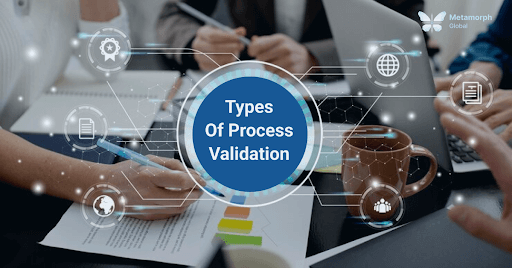Process validation is a cornerstone of good manufacturing practices (GMPs) in the pharmaceutical and medical device industries. It is defined by WHO as “The collection and evaluation of data, throughout the product life-cycle, which provides documented scientific evidence that a process is capable of consistently delivering quality products”
Process validation in Pharma progresses through four stages:
Prospective Validation→Retrospective Validation→Concurrent Validation → Revalidation.
It ensures that a process consistently delivers quality products that meet predetermined specifications. This critical practice is mandated by regulations such as 21 CFR 211 for pharmaceuticals and 21 CFR 820 for medical devices.
Let’s learn about types of process validation, exploring their objectives, methodologies, and applications.
Four Types of Process Validation
The classification and understanding of process validation types are essential for maintaining product quality and regulatory compliance in the pharmaceutical industry. This discussion is informed by insights from the comprehensive review article “Overview of Validation and Basic Concepts of Process Validation“ published in the Scholars Academic Journal of Pharmacy (SAJP) (2014). There are four types of Process validation:
- Prospective Validation
- Retrospective Validation
- Concurrent Validation
- Revalidation
Here is the in-depth analysis of the various validation methodologies, their purposes, and implementation strategies:
1. PROSPECTIVE VALIDATION
Definition: Prospective validation is conducted before the commercial distribution of a product. It establishes documented evidence that a system or process performs as intended based on preplanned protocols.
Purpose: This type of validation is essential for new processes, facilities, or products, ensuring their readiness for consistent and compliant manufacturing. It is performed on at least three consecutive production-size batches to confirm reproducibility and compliance with regulatory standards. Validation batches must adhere to Good Manufacturing Practice (GMP) guidelines to ensure they meet marketing authorization requirements if intended for commercial use.
Key Activities in Prospective Validation
Development of Protocols: Detailed protocols are created to outline objectives, testing methods, acceptance criteria, and responsibilities. These protocols provide a roadmap for validation and ensure all critical aspects of the process are addressed. The protocol includes:
- A summary of critical processing steps to investigate.
- A list of equipment and facilities, including calibration status.
- Finished product specifications for release.
- A list of analytical methods, as appropriate.
- Proposed in-process controls with acceptance criteria.
- Additional testing requirements with acceptance criteria and analytical validation.
- Sampling plans.
- Methods for recording and evaluating results.
- Functions and responsibilities of involved personnel.
- A proposed timetable for validation activities.
Pre-Implementation Testing: Laboratory and pilot-scale studies simulate manufacturing conditions to evaluate process parameters. Each step of the production process is categorized and examined for critical parameters that may influence the final product’s quality. A series of experiments are planned and documented to identify these critical parameters. The findings guide the preparation of master batch documents, including machine settings, component specifications, and environmental conditions.
Process Qualification: During process qualification, equipment and processes are tested under simulated or actual conditions to ensure reliability. Validation involves producing several batches under defined parameters to establish consistency. Typically, three consecutive batches within acceptable limits demonstrate sufficient validation. Additional considerations include:
- Using different lots of active raw materials and major excipients.
- Producing batches on different shifts.
- Using different equipment and facilities dedicated to commercial production.
- Evaluating the operating range of critical processes.
Extensive sampling and testing are performed at various production stages, with comprehensive documentation of results. Testing is also carried out on the final packaged product to confirm its quality.
Documentation: Comprehensive documentation is critical to prospective validation. It includes detailed records of testing, results, and conclusions, establishing the foundation for routine commercial production. This documentation incorporates:
- Limits, frequencies, and actions for exceeding limits.
- Recommendations for monitoring and in-process controls necessary for routine production.
- Batch manufacturing and packaging records or standard operating procedures (SOPs).
Advantages of Prospective Validation
- Identifies Potential Issues: Conducting validation before production begins minimizes risks of product failure and ensures process robustness.
- Regulatory Compliance: Adherence to pre-approved protocols enhances compliance with regulatory requirements.
- Product Quality Assurance: Thorough testing and documentation provide confidence in consistent product quality.
Challenges of Prospective Validation
- Time-Intensive: Planning and executing validation require significant time and effort.
- Resource-Heavy: Substantial resources are needed for equipment calibration, sampling, and testing.
- Complex Execution: Precise coordination and adherence to protocols are essential to achieve reliable outcomes.
By thoroughly addressing these aspects, prospective validation ensures that new processes and products meet stringent quality standards before entering the market, establishing a foundation for successful commercial production.
2. RETROSPECTIVE VALIDATION
Definition: Retrospective validation is the systematic process of using historical data to establish documented evidence that a manufacturing process consistently produces a product meeting its pre-defined specifications and quality attributes.
Purpose: Unlike other validation types, retrospective validation is performed on processes already in commercial use, making it particularly suitable for long-established processes that demonstrate stability and reliability over time. This approach evaluates past production and testing records to verify process control and compliance with regulatory standards. Retrospective validation is typically not suitable for newly developed processes or those that have undergone significant changes in equipment, operating procedures, or product composition.
Steps in Retrospective Validation
- Preparation and Protocol Development: The retrospective validation process begins with the preparation of a validation protocol. This document outlines the objectives, scope, and methodology to be used during the validation. The protocol should specify the data sources, statistical methods for analysis, and acceptance criteria for process performance.
- Data Collection: Historical production and testing data are gathered from multiple sources, including:
- Batch manufacturing and packaging records.
- Process control charts and maintenance logs.
- Records of deviations, corrective actions, and changes in manufacturing processes.
- Process capability studies and trend cards for finished product testing.
- Stability testing results.
- Selected batches should represent a wide range of production scenarios, including any deviations or batches that failed to meet specifications, to ensure a comprehensive review of process performance.
- Data Analysis and Review: Collected data is analyzed using statistical methods to identify trends, variations, and any deviations from the established specifications. A sufficient number of batches, typically between 10 and 30 consecutive batches, are examined to assess the consistency and reliability of the process. This data review should establish whether the process operates within acceptable limits.
In some cases, additional testing of retained samples may be required to supplement the historical data and provide a clearer understanding of process consistency. - Documentation and Reporting: The findings from the data analysis are compiled into a validation report. This document includes a detailed summary of the data reviewed, statistical evaluations, deviations identified, and conclusions drawn regarding process performance. Recommendations for process improvements or changes to in-process controls may also be included to enhance reliability and compliance.
Advantages of Retrospective Validation
- Cost-Effective Approach: Retrospective validation leverages existing historical data, reducing the need for additional resources, time, and testing compared to other validation methods.
- Applicability to Established Processes: This method is ideal for processes that have been operational and stable for an extended period, providing a reliable means of confirming process control without disrupting ongoing production.
- Regulatory Compliance: By validating historical data, organizations can ensure that processes meet regulatory standards and maintain product quality, which is particularly beneficial during audits.
Challenges of Retrospective Validation
- Data Quality and Availability: The reliability of retrospective validation depends heavily on the availability and quality of historical data. Incomplete or inconsistent records can undermine the effectiveness of this approach.
- Limited Applicability: This method is unsuitable for newly developed processes, products with recent formulation changes, or processes that have undergone significant modifications.
- Inflexibility: Retrospective validation does not allow for real-time process optimization. It focuses solely on past performance, potentially overlooking current inefficiencies or areas for improvement.
Key Considerations in Retrospective Validation
- The validation must be based on comprehensive and representative data from all batches produced during the review period.
- Data must include information on deviations, changes in equipment, and corrective actions to provide a holistic view of process performance.
- Thorough documentation is essential to satisfy regulatory requirements and demonstrate process consistency over time.
By reviewing historical manufacturing and testing data, retrospective validation serves as a valuable tool for verifying the reliability and consistency of established processes. Although it may not be suitable for dynamic or evolving manufacturing environments, its cost-effectiveness and applicability to stable processes make it a practical choice for many industries.
3. CONCURRENT VALIDATION
Definition: Concurrent validation is a validation method performed during actual production to confirm that critical processes are in control and producing products of consistent quality.
Purpose: Unlike retrospective validation, which relies on historical data, or prospective validation, conducted before production, concurrent validation happens in real-time as manufacturing occurs. This approach is often used in situations where immediate production is essential, such as for life-saving medications or critical medical devices. The product is released to the market during the validation runs, making it vital to ensure strict compliance and rigorous monitoring throughout the process.
Concurrent validation is appropriate only under exceptional circumstances where the urgency of production outweighs the ability to complete validation beforehand. Such situations require careful planning, detailed justification, and approval by authorized personnel. This ensures that even under the pressure of immediate production, product safety and quality are not compromised.
Steps in Concurrent Validation
- Monitoring Critical Parameters: Continuous monitoring of critical process parameters and in-process controls is the cornerstone of concurrent validation. Each critical step in the manufacturing process is closely observed and documented to ensure it operates within pre-defined specifications. This involves real-time data collection, which serves as evidence of process consistency and control.
- Product Testing: Comprehensive testing of the final product is essential in concurrent validation. The end product must meet established quality specifications, and additional tests may be conducted to confirm product integrity. These tests validate that the product is safe for use and performs as intended.
- Justification and Authorization:
The decision to conduct concurrent validation must be supported by a well-documented justification. This includes detailing why validation could not be completed before production, the criticality of the product, and how compliance will be ensured during the process. Approval from authorized personnel is mandatory to proceed. - Documentation:
Documentation for concurrent validation mirrors the requirements for prospective validation. Every step of the process, from monitoring to product testing, must be meticulously recorded. This documentation serves as a regulatory requirement and ensures traceability for future reference or audits.
Advantages of Concurrent Validation
- Simultaneous Production and Validation:
Concurrent validation allows production to continue while validation is performed, significantly reducing lead times. This is especially beneficial in scenarios where timely availability of the product is critical. - Real-Time Assurance:
The real-time nature of this validation method provides immediate assurance of process reliability. Any deviations or issues can be identified and addressed promptly, reducing the risk of non-compliance. - Regulatory Acceptance in Critical Situations:
Regulatory authorities may accept concurrent validation in exceptional cases, provided robust documentation and justification is supporting its necessity.
Challenges of Concurrent Validation
- High Risk:
The simultaneous nature of production and validation introduces significant risks. If the process fails during validation, the entire batch could be compromised, leading to product recalls, financial losses, and reputational damage. - Stringent Monitoring Requirements:
Concurrent validation demands rigorous monitoring and control to ensure compliance. Any lapses in monitoring can lead to undetected deviations, potentially affecting product quality. - Documentation Intensity:
The requirement for extensive, real-time documentation can be resource-intensive, requiring dedicated personnel and systems to manage the data.
Key Considerations
- Exceptional Circumstances:
Concurrent validation should only be used under exceptional conditions where the urgency of product availability is critical. The decision must be carefully evaluated, with a thorough risk assessment conducted beforehand. - Pre-Defined Criteria:
Clear acceptance criteria for critical parameters and end-product specifications must be established before beginning concurrent validation. This ensures that all validation efforts are aligned with regulatory and quality standards. - Continuous Improvement:
Insights gained from concurrent validation should be used to refine and optimize processes. Any deviations or anomalies identified during the process should be thoroughly investigated, and corrective actions implemented to prevent recurrence.
Concurrent validation is a pragmatic approach that balances the need for immediate product availability with the requirement for rigorous quality assurance. By ensuring comprehensive monitoring, robust documentation, and strict adherence to predefined standards, it serves as a valuable tool in maintaining product integrity under time-sensitive circumstances. However, its inherent risks require careful planning and execution to ensure compliance with regulatory and operational requirements.
During this stage, it is critical to collect and analyze data from production batches to confirm that the process can meet predefined quality criteria. Sampling plans are developed to capture representative data, ensuring the reliability of results. Statistical analysis helps identify deviations, allowing for corrective actions to be taken promptly.
Process Qualification ensures that all components of the process—equipment, personnel, and procedures—are aligned with regulatory expectations and deliver consistent product quality. This stage establishes a strong foundation for continuous process control in subsequent phases of production.
- Continued Process Verification
Continued Process Verification (CPV) is the final stage of process validation, which ensures the process remains validated during commercial production. This stage involves ongoing monitoring, data collection, and periodic reviews to maintain the integrity of the manufacturing process.
- Best Practices:
- Implementing a data-driven monitoring program to track process performance continuously.
- Conducting periodic reviews to assess process stability and compliance with quality standards.
- Maintaining robust documentation to provide traceability and support regulatory compliance.
Data collection plays a critical role in CPV, helping to identify trends, detect deviations, and manage process variations effectively. Through real-time monitoring, companies can ensure that their processes remain in a validated state, minimizing the risk of non-compliance and product quality issues.
Corrective actions are initiated when deviations are detected, ensuring that any issues are addressed swiftly to maintain product quality. Continuous improvement is a key focus, with regular updates and adjustments made to refine the process over time. CPV ensures that organizations sustain a reliable, high-performing process that consistently meets customer and regulatory expectations.
4. REVALIDATION
Definition: Revalidation ensures that changes in processes, equipment, or environmental conditions do not negatively impact process characteristics or product quality.
Purpose: This process involves re-evaluating and re-establishing evidence that a system continues to operate within the specified parameters. Like initial validation, revalidation requires detailed documentation to demonstrate compliance and safeguard product integrity. It is essential for maintaining process reliability and meeting evolving regulatory and operational standards.
Revalidation is particularly critical when changes occur in raw materials, equipment, or manufacturing processes. For instance, variations in raw material properties such as particle size, moisture content, or density can significantly impact product quality. Similarly, introducing new equipment, altering batch sizes, or modifying environmental conditions necessitates revalidation to ensure the process remains consistent and capable of delivering the desired results.
When to Perform Revalidation
Revalidation is required under the following circumstances:
- Changes in Raw Materials:
Any modification in the physical properties of raw materials, such as density, viscosity, or particle size, may influence the process or product quality. Additionally, sourcing raw materials from a new manufacturer warrants revalidation. - Changes in Packaging Materials:
Alterations to the primary container or closure system necessitate revalidation to ensure compatibility and maintain product integrity during storage and transportation. - Process Modifications:
Adjustments to critical parameters, such as mixing times, drying temperatures, or batch sizes, require revalidation to confirm that these changes do not compromise product quality. - Equipment Changes:
Introducing new equipment or replacing existing equipment with updated versions (even if “like for like”) requires qualification and, in some cases, revalidation. For example, adding an automated detection system to existing machinery necessitates revalidation to ensure process consistency. - Facility Changes:
Modifications to the plant layout, environmental controls, or manufacturing areas call for revalidation to maintain compliance with regulatory standards and prevent contamination risks. - Periodic Evaluations:
Even in the absence of significant changes, facilities, systems, equipment, and processes should undergo periodic evaluations to confirm their ongoing validity. - Deviations or Failures:
In response to production deviations, failures, or quality issues, revalidation ensures that corrective actions restore the process to a validated state.
Steps in Revalidation
- Assessment:
The first step involves assessing whether revalidation is necessary. This includes reviewing process changes, deviations, or quality concerns to determine the scope and extent of revalidation. Decisions not to revalidate must be fully justified and documented. - Protocol Preparation:
A detailed revalidation protocol is prepared, outlining the objectives, scope, methodology, and acceptance criteria. This document ensures that the revalidation process aligns with regulatory and organizational requirements. - Data Collection and Testing:
Data is collected from historical records, batch processing logs, and product testing results. Revalidation also includes conducting tests similar to those performed during the initial validation, focusing on the impact of specific changes. - Documentation and Reporting:
The findings from revalidation are compiled into a comprehensive report. This document summarizes the testing results, statistical analysis, and conclusions about process performance. Recommendations for additional corrective actions, if necessary, are also included.
Advantages of Revalidation
- Maintains Long-Term Process Integrity: Revalidation ensures that processes remain in control over time, even in the face of changes or operational challenges.
- Addresses Evolving Regulatory Requirements: Regular revalidation helps organizations stay compliant with changing industry standards and regulatory expectations.
- Identifies Potential Risks: By reassessing processes and equipment, revalidation can identify and address potential risks to product quality before they escalate.
Challenges of Revalidation
- Resource-Intensive: Revalidation can be costly and time-consuming, particularly for complex processes or large-scale facilities.
- Determining the Scope: Identifying the appropriate scope and extent of revalidation requires thorough analysis and careful planning.
Key Considerations for Revalidation
- Documentation requirements for revalidation are equivalent to those of initial validation and must include detailed records of changes and their impact.
- A decision to forgo revalidation must be supported by clear, documented evidence demonstrating that the process remains valid.
- Periodic evaluations, even in the absence of significant changes, are essential to confirm the continued reliability and validity of facilities, systems, and processes.
Revalidation plays a critical role in safeguarding product quality, ensuring compliance, and addressing changes in the manufacturing environment. By proactively implementing revalidation protocols, organizations can maintain the integrity of their processes and deliver consistent, high-quality products.
| Validation Type | Key Feature | When to Use | Example Scenario |
|---|---|---|---|
| Prospective | Pre-implementation testing | New product or process. | Launching a new drug formulation. |
| Retrospective | Historical data analysis | Established processes with adequate historical records. | Auditing legacy production lines. |
| Concurrent | Real-time validation | Immediate production needs or limited production batches. | Producing a life-saving drug during an emergency. |
| Revalidation | Repeat validation efforts | Process changes, periodic checks, or compliance updates. | Scaling up batch size from pilot to commercial. |
For more insights into ensuring robust and efficient process validation, join our Statistical Methods for Process Validation Masterclass. Learn from industry experts and enhance your understanding of statistical tools and techniques to achieve operational excellence.
Register Now to elevate your validation strategies.







